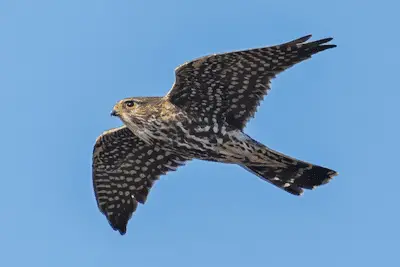Merlin
(Falco columbarius)
As the smallest raptor in Europe, the Merlin is a dashing small falcon that predominantly hunts small birds in open country.

In most parts of Europe, Merlins can only be seen as rare winter visitors. Northern breeding populations of the Merlin migrate to central Europe, and in some cases even southern Europe.
In their wintering range, Merlins can sometimes be seen close to urban centers, where they feed on the many songbirds attracted to bird feeders.
While the Merlin is currently not endangered, it’s essential to protect its breeding habitats, which are also important for many other species.
Merlin facts
As the smallest raptor in Europe, the Merlin is a rare winter visitor in most parts of Europe, while its breeding range is restricted to the northernmost regions.
Merlin bird size
When considering Merlin size, keep in mind that the Merlin is not only the smallest European falcon, but also the smallest raptor species in Europe.
- Wingspan: 61-67 cm
- Length: 28-34 cm
- Weight: 190-210 g (females), 160-180 g (males)
The Merlin is smaller than the Common Kestrel, and similar in size to a medium sized dove.
Appearance
The Merlin looks like a miniature falcon that is slightly larger than its favorite prey – starlings and other small songbirds. The female has an overall brown coloration, while the male is blue grey on top, with light orange bars on the bottom.

Sexual dimorphism
Similar to almost all European falcon species, female Merlins are larger than their male counterparts.
Lifespan
A maximum age of 12 years has been recorded in the wild.
Scientific name and taxonomy
The scientific name of the Merlin is Falco columbarius. Two subspecies are known, both of which occur in Europe – one in Iceland, and the second one in the rest of Europe.
Merlin distribution
The Merlin is a bird of the northernmost parts of Europe, where it can be found in the northern parts of Scandinavia, Ireland, UK, Iceland, the Baltics, and Russia.
Merlin habitat
The Merlin prefers open country interspersed with woods, and is most commonly found in the taiga, as well as heathland or moorland. While wintering, it can be found in a wide variety of open habitats. In some parts of its range, the Merlin shares its habitat with the much larger Gyrfalcon (Falco rusticolus).
Merlin population size
The European population of the Merlin is estimated to be between 39,000 and 49,000 breeding pairs by BirdLife International. The majority of these pairs breed in the European part of Russia (up to 30,000 pairs), followed by Norway (up to 6,500 pairs), Sweden (up to 5,700 pairs), and Finland (up to 3,000 pairs).
Merlin behavior
Similar to many other falcon species, the Merlin takes most of its prey on the wing, but unlike its larger cousins, such as the Peregrine Falcon, Merlins usually catch their prey close to the ground.
Often the Merlin tries to surprise its prey by flying at a low altitude of just a few feet above the ground. If it doesn’t succeed right away, it will also chase its prey over long distances.
Feeding and diet
The most important food source of the Merlin are small songbirds, with the specific species composition depending on the location. In addition to birds, it also takes dragonflies and other winged insects during the summer.
Breeding
In some locations, Merlins nest on the ground, and simply scrape out a small hollow into which the female lays the eggs. In other locations, they use old nests built by crows or other raptors, such as buzzards. Finally, where available, Merlins also nest in cliffs.
The female lays 3-6 eggs, which are incubated for up to 33 days. After hatching, the young falcons stay in the nest up to 32 days, and continue to be fed for weeks after they fledge and leave the nest.
Merlin Migration
The Merlin is a partial migrant, with its northernmost populations being strictly migratory, while more southern populations are partially sedentary. As with many other raptor species, juveniles are more mobile, and travel far from their breeding grounds.
Merlin conservation status
Currently the European population of the Merlin appears to be stable, and has thus been classified as of “Least Concern” by BirdLife International. However, local populations in some parts of its range consist of a handful of pairs, which makes it locally vulnerable to adverse events.
Threats
The biggest threat to the Merlin is destruction of its habitat, including heathland and moorland. However, in many cases it’s possible to recreate destroyed habitats, and this can be of great benefit to many other species of animals and plants. As a bird hunter, the Merlin is also very vulnerable to pesticides, and should therefore be closely monitored to make sure that it isn’t affected by pesticides.
